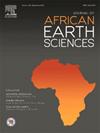利用重力和航磁数据集模拟尼日利亚贝努埃海槽中下游的地质特征和构造
IF 2.2
4区 地球科学
Q2 GEOSCIENCES, MULTIDISCIPLINARY
引用次数: 0
摘要
了解地下构造是预测盆地演化及其资源的关键。贝努埃海槽是一个大型构造,虽然缺乏详细的区域地下研究,但已经得到了较好的研究。我们的研究目的是通过二维和三维模型来突出和清晰地显示地下地质结构/特征。利用高分辨率航磁和重力数据集,对海槽的地质特征和地下构造纹理进行了二维和三维的测绘和研究。利用重磁数据集构建二维地质模型,绘制基底断裂、基底深度、居里深度和莫霍深度,并对盆地地壳结构进行解释。确定了3个明确的基底断裂系统:NE-SW、NW-SE和ENE-WSW。基于古应力场解释的基底断裂运动学分析,认为基底断裂是在海槽演化早期通过板块构造活动形成的。然后,我们仔细地模拟了三维关键界面(基底表面、居里等温线和莫霍线),在那里我们估计了它们的深度并解释了它们的形态。基底平均深度为4.3 km,基底低洼区域被解释为次盆地;这些是沉积物(沉积中心)聚集的合适地点,而基底高点被认为是基底隆起和块体。居里深度(磁层底部的深度)在整个地区相对平坦,而莫霍盆地则直接在盆地下方隆起。我们观察到盆地正下方地壳变薄,我们认为这是伸展裂陷作用的结果。揭示了海槽的地下构造构造,揭示了海槽的大陆成因:地壳裂陷和伸展,伴随着断裂、莫霍变浅、岩浆侵位和地壳减薄和伸展。本文章由计算机程序翻译,如有差异,请以英文原文为准。
Modelling geologic features and structures in the Middle and Lower Benue Trough of Nigeria from gravity and aeromagnetic data sets
Understanding subsurface structures is key to predicting the evolution of a basin and its resources. The Benue Trough is a mega-structure that has been moderately well studied, although a detailed regional subsurface study of the basin is lacking. Our aim in this study is to highlight and show clearly the subsurface geologic structures/features through 2D and 3D models. We used high-resolution aeromagnetic and gravity datasets to map and investigate geologic features and subsurface structural texture of the trough in 2 and 3 dimensions. We constructed geologic models in 2D from gravity and magnetic datasets and mapped basement faults, depth to basement, Curie, and Moho depths, and interpreted the crustal structure of the basin. Three well-defined basement fault systems were identified: NE-SW, NW-SE, and ENE-WSW. Based on basement fault kinematics through paleo-stress field interpretation, we showed that the basement faults evolved through plate tectonic activities at the earlier stage of the evolution of the trough. We then carefully modelled in 3D critical interfaces (basement surface, Curie isotherm, and Moho), where we estimated their depths and interpreted their morphologies. The average basement depth is 4.3 km and areas of basement lows are interpreted as sub-basins; these are suitable sites for the accumulation of sediments (depocentres) while the basement highs are considered basement uplifts and blocks. The Curie depth (the depth to the bottom of the magnetic layer) is relatively flat across the area while the Moho is uplifted directly under the basin. We observed the crust to be thinned directly under the basin which we attributed to extensional rifting processes. This study exposed the subsurface tectonic architecture of the trough and demonstrated its continental origin due to crustal rifting and extension, accompanied by faulting, Moho shallowing, magma emplacement, and crustal thinning and stretching.
求助全文
通过发布文献求助,成功后即可免费获取论文全文。
去求助
来源期刊

Journal of African Earth Sciences
地学-地球科学综合
CiteScore
4.70
自引率
4.30%
发文量
240
审稿时长
12 months
期刊介绍:
The Journal of African Earth Sciences sees itself as the prime geological journal for all aspects of the Earth Sciences about the African plate. Papers dealing with peripheral areas are welcome if they demonstrate a tight link with Africa.
The Journal publishes high quality, peer-reviewed scientific papers. It is devoted primarily to research papers but short communications relating to new developments of broad interest, reviews and book reviews will also be considered. Papers must have international appeal and should present work of more regional than local significance and dealing with well identified and justified scientific questions. Specialised technical papers, analytical or exploration reports must be avoided. Papers on applied geology should preferably be linked to such core disciplines and must be addressed to a more general geoscientific audience.
 求助内容:
求助内容: 应助结果提醒方式:
应助结果提醒方式:


